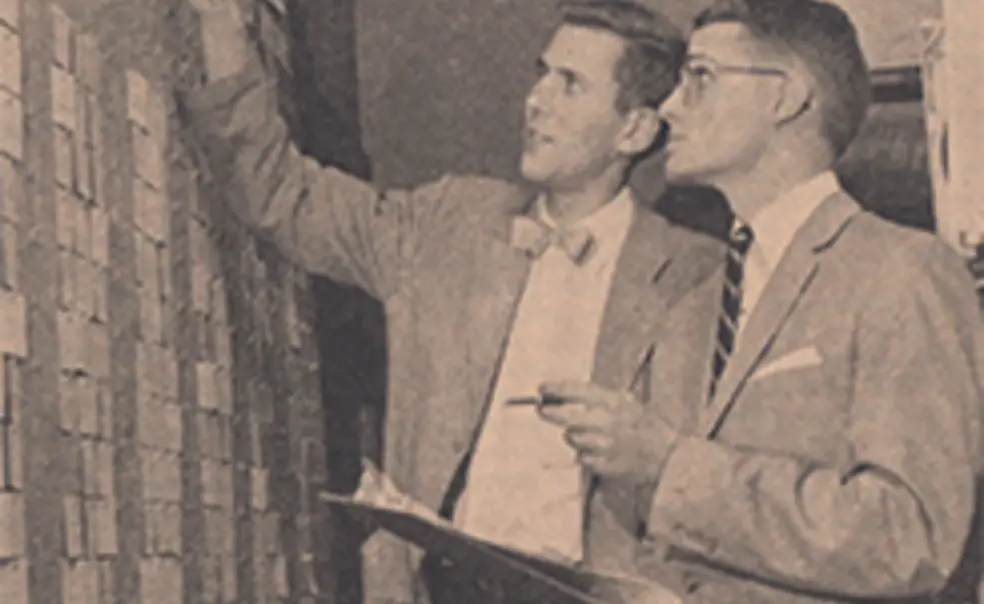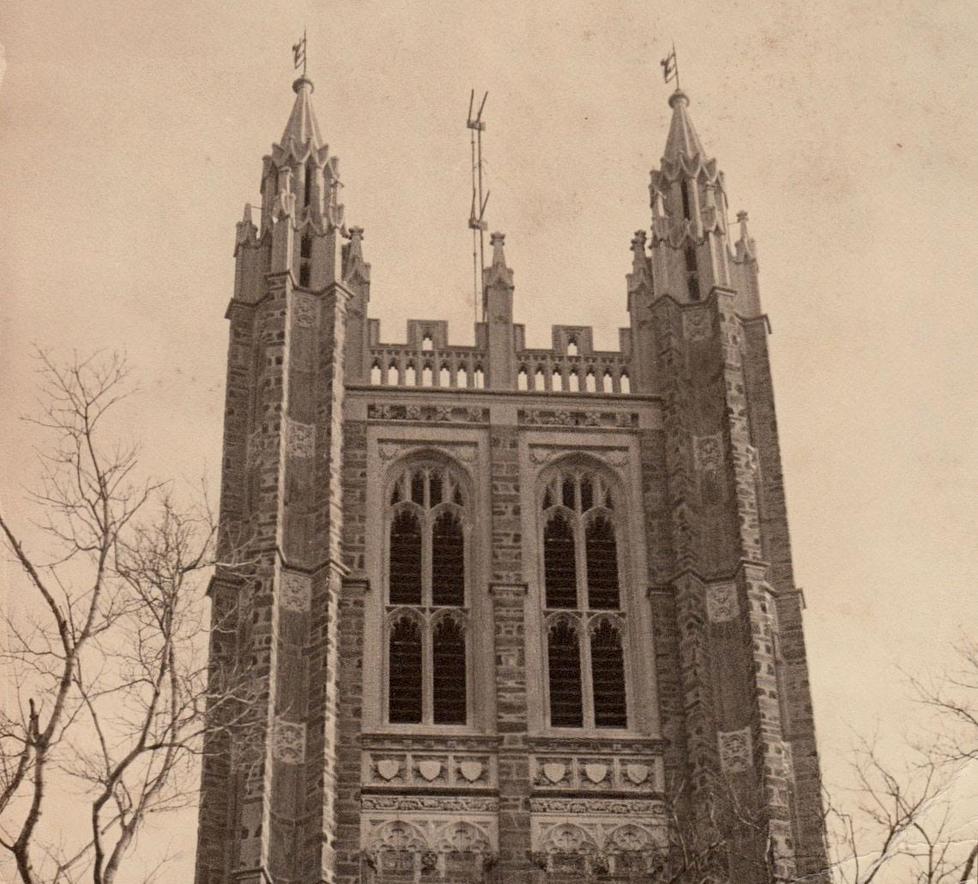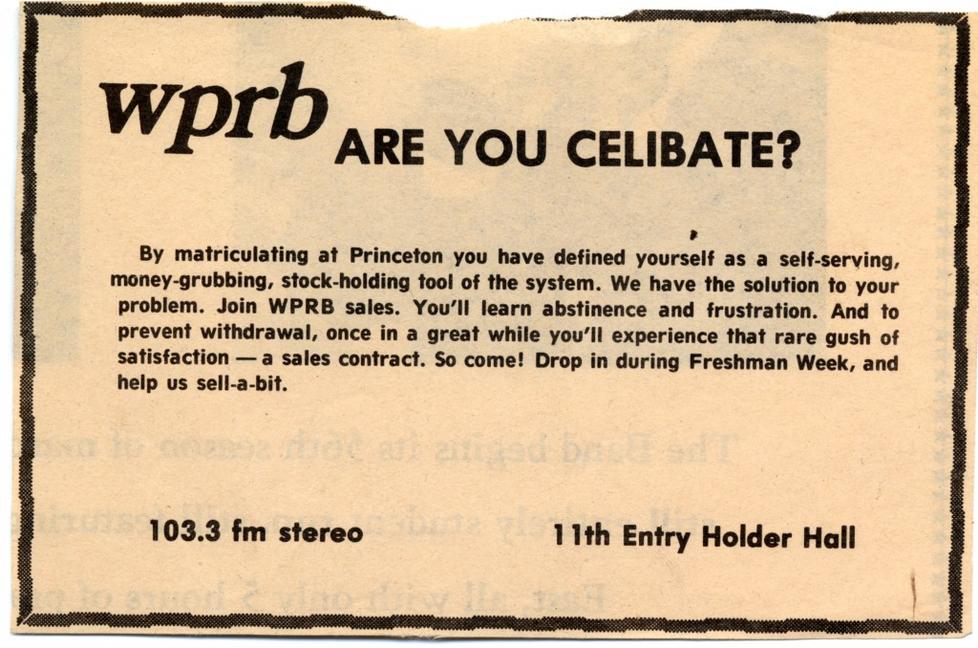I want a thousand guitars, I want pounding drums,
I want a million different voices speaking in tongues.
This is radio nowhere, is there anybody alive out there?
— Bruce Springsteen, 2007
WPRB (initially WPRU) began in a dorm room in 1940; it has that in common with many, many more brilliant innovations — and unsavory disasters — than all the garages in the Western Hemisphere combined. But running a radio station there in the 1940s with even minimal technical standards (soundproofing, cables, chattering news machines, sobbing management, etc.) was untenable. So after a WWII hiatus, the revived station (in the person of young adviser Jim Robinson ’43) unearthed campus space previously abandoned by the overflow from Pyne Library — the books were falling apart in the dampness. On March 19, 1945, the station reopened for closed-circuit AM business in Holder Hall, between the basement bathrooms.
As the station painstakingly acquired professional mixing, modulation, and transmission equipment over the years and upgraded to commercial FM, this sophisticated electronic gear would descend into one of the wettest environments on campus. Raised flooring kept most of the rivulets out of sight, but the atmosphere was, uh, electric. The advent of broadcasting over summer vacation in 1974 brought stifling heat to the mix, and even with portable air conditioners venting upward from the window wells of the dorm, the similarity to your favorite zoo’s jungle habitat was hard to miss.
When I worked at ABC News a few years afterward, I ran across WPRB alumnus Charlie Gibson ’65, and one year the station trustees asked me to invite him to speak at the students’ annual year-end banquet. The crack newsman accepted enthusiastically and, recalling no doubt the oppressive atmosphere during his tenure 20 years earlier, cheerfully asked, “Where is the station now, anyway?” At least his prescience was admirable: The station did indeed move from Holder, although it happened a full 20 years later, after a 59-year stay in the subterranean damp; on June 9, 2004, WPRB reopened for business down campus in the spiffy new Bloomberg Hall. In the basement.
The reason I mention all this is that, essentially without exception, no one at the station cared much. Fitful temperatures, unfit humidity, and mushroom-like lack of Vitamin D aren’t minor annoyances to radio talent (as we call the colorful assemblage in front of the mics) — they’re simply irrelevant to the weaving of images and threads of logic into the air, where with luck they meet with the ears and minds of kindred spirits to join in cultural concert. Doing live broadcasting well requires ideas, discipline, and practice, which is why WPRB is an educational nonprofit corporation: You learn a lot there, although that may well involve the suspension of disbelief, or at least a good antiperspirant.
Intriguingly, that’s only half the educational story. In high contrast to the outbound, free-flowing creativity of an FM air slot, the interactive discipline of running an organization on a schedule is not only contrapuntal but completely essential to the staff, the listeners, and even the FCC, which can take your license away. Along with other incorporated extracurriculars like The Daily Princetonian and Triangle, WPRB glories in the challenge of having the students control not only the creative elements of the enterprise and its product, but the back-office decision-making that makes it a going concern. Each has adult advisers who are there to be of assistance, and trustee boards of graduates who instill continuity and a modest level of perspective, but the day-to-day business — and that’s exactly what it is — lives or dies on the management skill of the students.
WPRB exemplifies this built-in friction more than most because of the glaring difference between the invoices and ledgers on one hand and the hip-hop, classical, AOR (album-oriented rock), sports, kids’ stories, news, and all the other ethereal presentations in its Theater of the Mind (as we like to say in the biz) on the other. As proud heirs to Casey Kasem, Orson Welles, Milton Cross, and Jean Shepherd, there’s room for just about anyone with a brain in college radio; a voice doesn’t hurt either, but is somewhat negotiable. The ethos is poignantly captured through June in the Wiess Lounge at Mudd Library in the exhibition WPRB: A Haven for the Creative Impulse, painstakingly constructed by station adviser Mike Lupica and student henchfolk to give substance to the staff’s aural flights of fancy over 75 years, including audio, ads, photos, and the inevitable station T-shirts and trinkets. You can also find more of Mike’s work at the new wprbhistory.org, an ever-morphing compilation of station tales, audio cuts, and imagery that is growing as station alums clean out their closets and liquor cabinets, rediscovering gems from the past during the 75th anniversary celebrations this year.
Additionally, Barksdale Maynard ’88 has done his usual exemplary job in this issue of Your Favorite Periodical, walking us through much of the flavorful history of WPRB and its denizens in the various physical basements and mental ivory towers of 75 years. So here in PAW virtuality, we’re going to take advantage of Webinology and look at a very few isolated examples of the sorts of audio adventures the jocks have blasted out — and do to this day — to maybe 5 million potential (and profoundly unsuspecting) community listeners in the 103.3 MHz broadcast footprint, and to billions over wprb.com.
Warming up with the basics, let’s consider the humble station ID, mandated hourly by the FCC and clearly a challenge to creatives everywhere.
Try this global perspective (completely legal, BTW) from Tesla Monson ’07.
Or this deft critique (legal and tasteful) of a certain dance craze from John Shyer ’78.
Similar emotional creativity spills over into program promotions — here’s a spot for groundbreaking Ladies First from Gayle Wald *95 and Joanne Gottlieb *02 in the early ’90s.
Long a haven for commercially underrepresented and fringe music of all stripes, from jazz fusion, prog rock, and hip-hop to reggae and Indian ragas, the station went so far as an eight-hour marathon highlighting enigmatic The Residents as part of its Spotlight series 20 years ago.
And here’s an early promo for John Weingart *75’s “Music You Can’t Hear on the Radio,” which broke ground for non-undergrads on the air in 1974. The show continues as a listener favorite to this day, and has been the touchstone for an assortment of talented community DJs on the air.
Various special programming has always acted as a beacon, and often a cautionary tale, to succeeding student broadcasters. Paul Dunn ’58 and Dick Morgan ’58 decided in the fall of 1956 the station needed some PR buzz, so decided to go for the world record for a two-man radio air team: a 100-hour marathon. Things got a bit surreal along about hour 76.
News went through a number of phases at the station, and in the unrest of the Vietnam era, some reporters were even arrested. Things were at least a bit calmer at the campus community Vietnam Moratorium activities in October 1969, cited in this sales promo:
Radio drama has put in various appearances as well over the years. Here’s a lively ’cast in the fall of 1970 recreating that legendary Princeton-centric radio script, David Koch and Orson Welles’ War of the Worlds from 1938.
Big names have popped up over the years; Eric Lyon ’84 and Suzanne Windels ’85 from the WPRB classical department (which has impressively held down the crucial morning drive slot for decades now) journeyed to New York in 1983 to interview Leonard Bernstein.
But the one personality (motive force would be more precise) who came closest to embodying WPRB was the unique radio raconteur Jean Shepherd. A madly gifted observer of the American scene — his magnum opus, A Christmas Story, is in the National Film Registry — and nimble writer as well, he was truly in his element with simply a microphone and 45 minutes to fill, as he did for years on WOR-AM in New York. He appeared at lectures and performances at Princeton as early as 1956, and WPRB began to sponsor annual appearances at Alexander Hall in 1966; they ran annually for 30 years, until three years before his death in 1999. Back in April 1969, Shepherd teamed up with a WPRB great, the late Jeff Meyers ’70 — like Shepherd a lively Midwest radio voice — after the Alexander Hall show for a freeform excursus on WPRB, radio generally, and American culture (Consider: Shep is describing Mad Men, except four decades in advance.) This is what the Theater of the Mind can be when the stars align.
Forty-six light years away from you, some stressed Klingon with a long commute is just now tuning in to Shep and Jeff, and wondering what sort of magical place gave rise to such gleeful shenanigans, complete with built-in postdoctoral philosophical depth.
It came from the basement.
















No responses yet